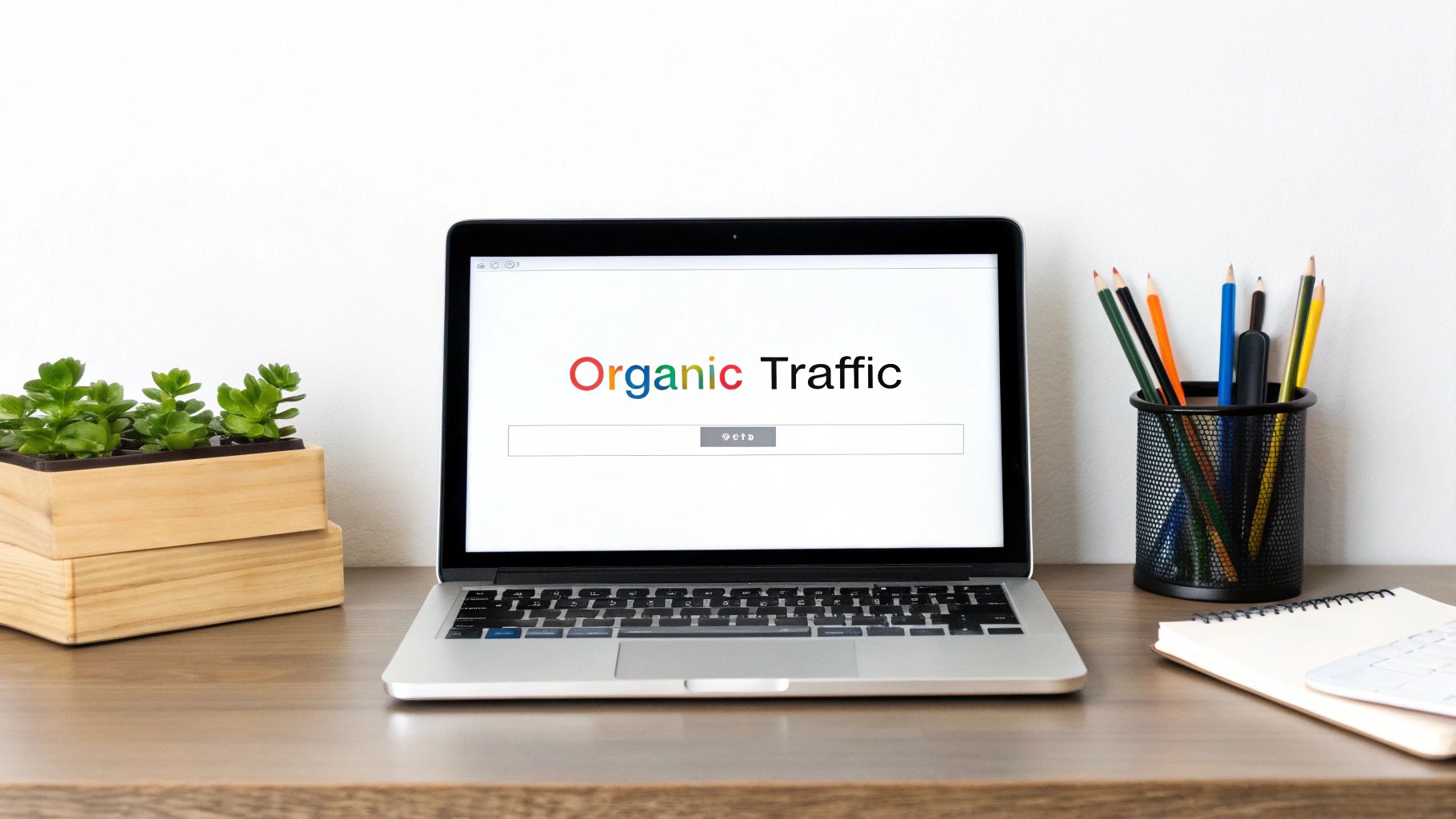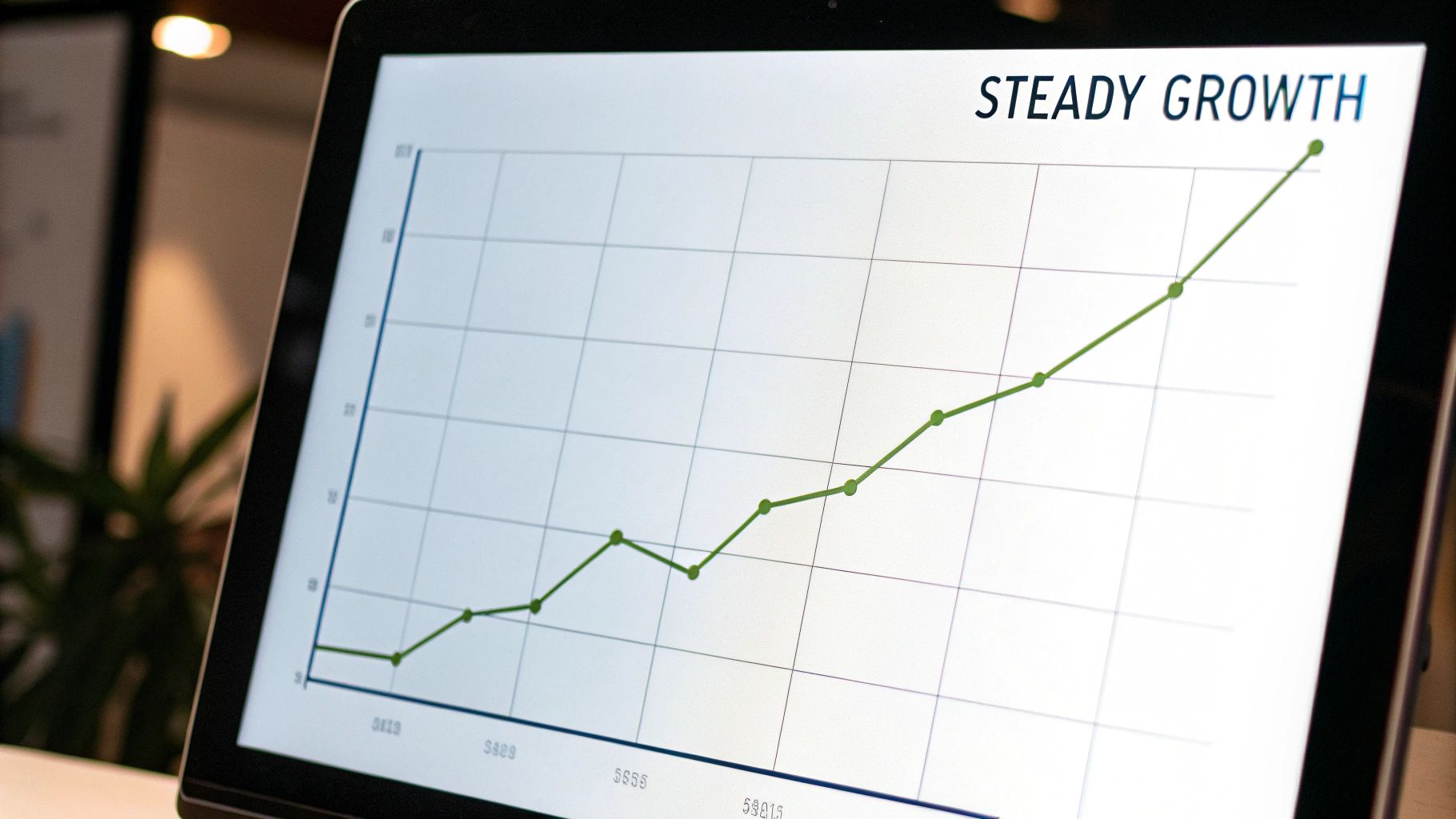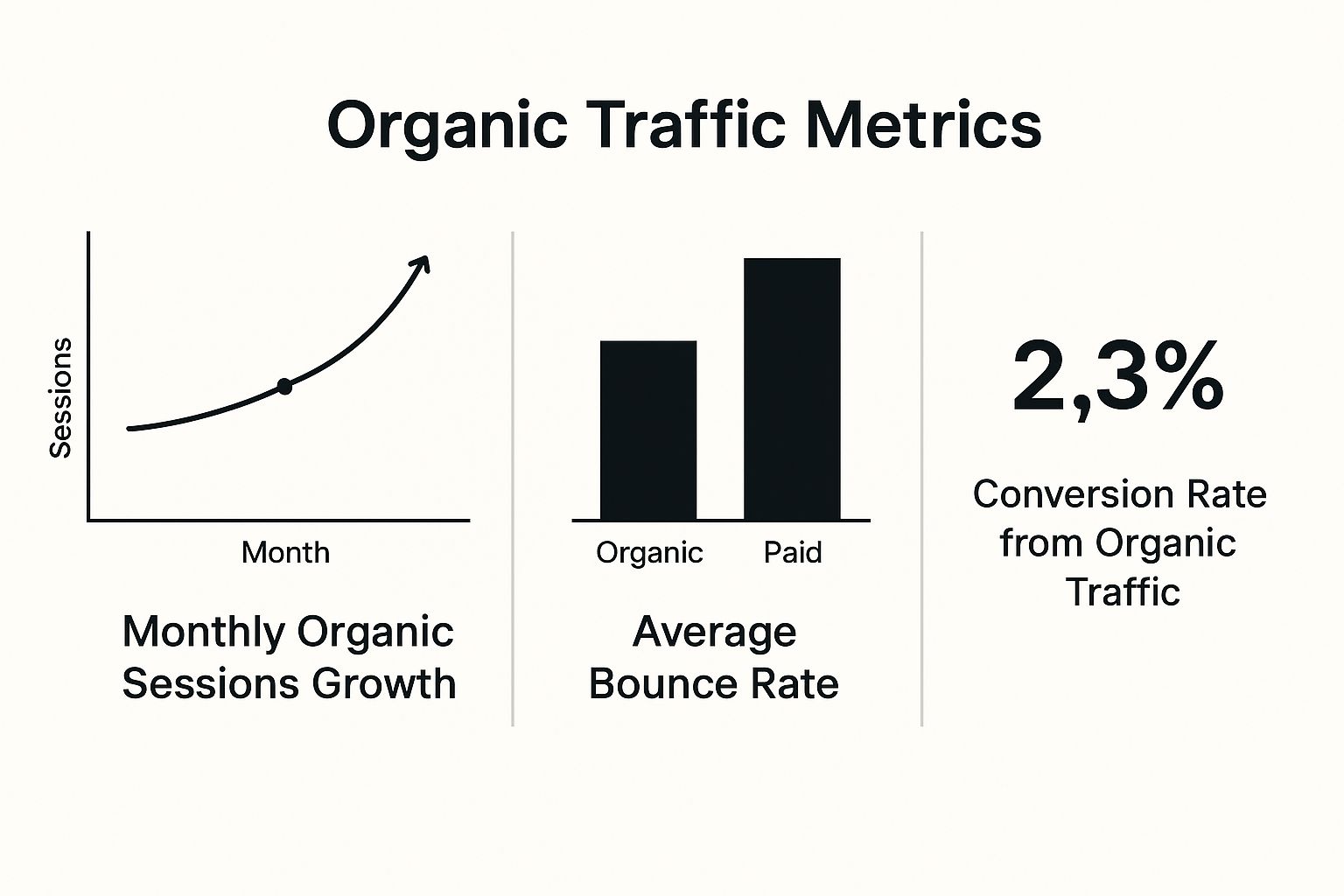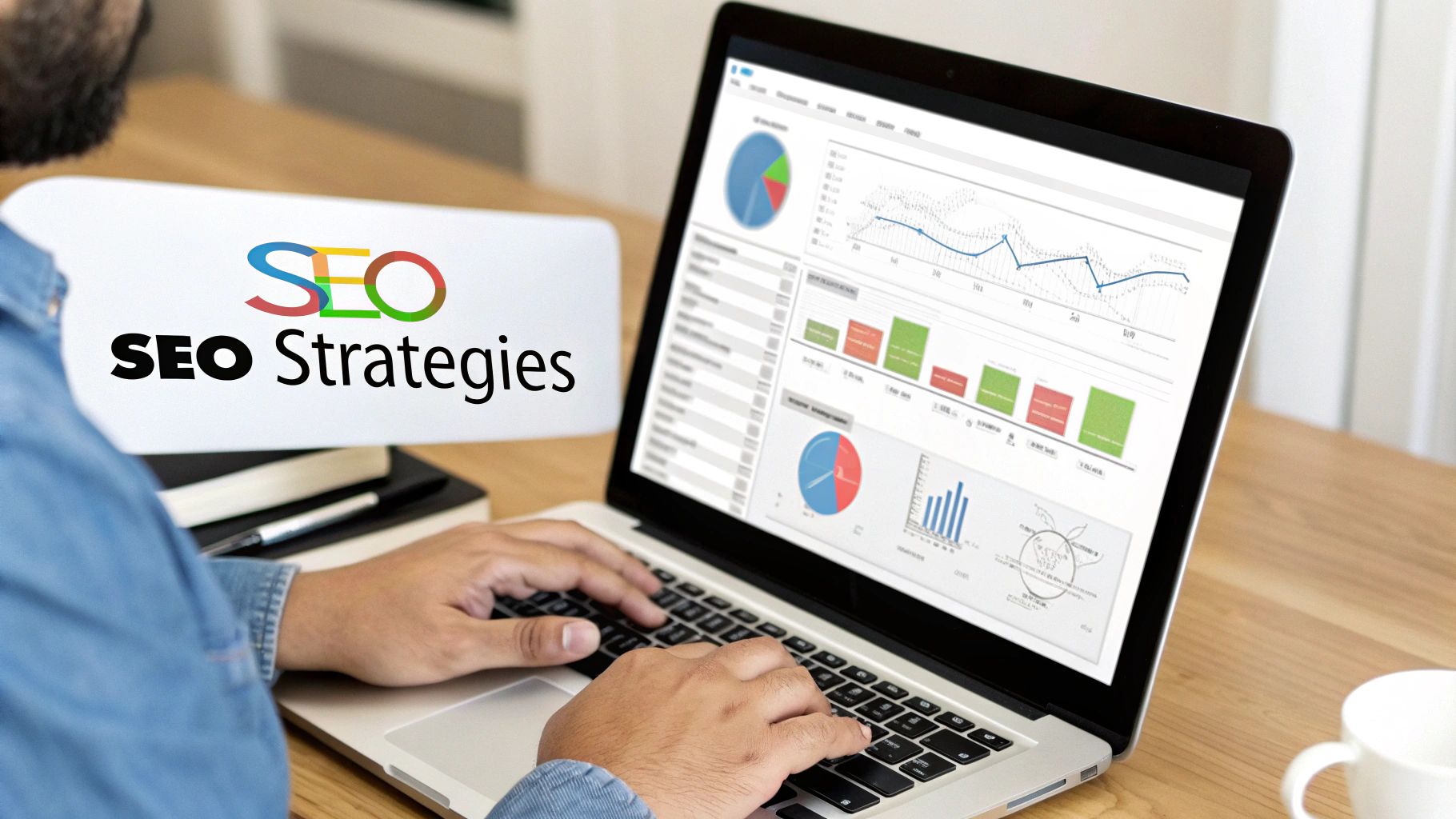
What Is Organic Traffic and Why It Matters Most
Share
Let's cut through the jargon. Organic traffic is simply the people who find your website through a search engine—like Google or Bing—without you paying for an ad. Think of it as word-of-mouth for the digital age.
These aren't just random visitors. They found you because they typed in a question or a need, and the search engine decided your website was one of the best answers.
So, What Is Organic Traffic, Really?

Let’s use an analogy. Imagine your restaurant equipment website is a physical storefront. Paid traffic is like paying someone to stand on the corner and hand out flyers. It works, but the moment you stop paying them, the foot traffic stops. It’s a faucet you turn on and off.
Organic traffic is different. It’s like building a reputation for being the best shop in town. A chef hears from another chef that you have the most reliable commercial convection ovens. Or they're walking down the street, looking for exactly what you sell, and your shop is right there on Main Street—prime real estate. They walk in because you’re in the right place, looking trustworthy and relevant.
That’s what happens when a potential customer searches for "best commercial deep fryer" and clicks on your product page or your comparison guide. They came to you on their own terms, actively looking for a solution.
This is why these visitors are so incredibly valuable. They have a specific problem or need, and they believe you can solve it. This built-in trust and high intent are why organic traffic often leads to better engagement and, ultimately, more sales.
Organic traffic isn’t just a number on a dashboard. It’s a direct measure of your website's authority and relevance. It shows how much search engines—and your customers—trust you.
The data backs this up in a big way. Roughly 53% of all trackable website traffic comes from organic search, making it the single largest channel for most businesses. You can read up on more search traffic trends to see just how dominant it is. For restaurant equipment sellers, that means more than half of your potential online customers are waiting to find you through a simple search.
To get a clearer picture, here's a quick breakdown of its key features.
Organic Traffic at a Glance
The table below summarizes the core characteristics that define organic traffic.
| Characteristic | Description |
|---|---|
| Source | Search engines like Google, Bing, DuckDuckGo, etc. |
| Cost | Earned, not paid. No direct cost per click or impression. |
| Visitor Intent | High. Users are actively searching for information, products, or solutions. |
| Sustainability | Long-term. A strong ranking can deliver traffic for months or years. |
| Trust Factor | High. Users tend to trust organic results more than paid ads. |
Ultimately, investing in your organic traffic is about building a lasting asset for your business. It takes consistent effort through what's known as Search Engine Optimization (SEO), but the payoff is a steady stream of high-quality visitors that doesn't vanish when you pause your ad campaigns.
Why Organic Traffic Is a Core Business Asset

So, we’ve covered what organic traffic is. But the real question is, why should you care? It’s more than just a number on a report; it's a foundational asset that keeps delivering value long after you've published a piece of content or optimized a product page.
Unlike a paid ad campaign that vanishes the moment you stop paying, organic traffic builds a lasting online presence. Let's break down the three biggest reasons why it’s so critical for your business.
It Builds Unshakeable Credibility and Trust
Think about it from your customer's perspective. When they search for a solution to a problem, they're looking for an expert, not just another sales pitch. Showing up at the top of Google's organic results is a massive vote of confidence from the search engine itself. It tells users your site is a legitimate, authoritative resource.
That kind of trust is something paid ads struggle to replicate. People are smart—they can spot a sponsored link a mile away and know the difference between a paid placement and a result that earned its spot. Ranking organically gives you an authenticity that money just can't buy.
A high organic ranking is the digital equivalent of a trusted recommendation. It tells users that you are a reliable authority in the restaurant equipment space, making them more receptive to your message before they even click.
This built-in credibility is a huge competitive edge. The visitors who arrive through organic search are already predisposed to trust you, which makes a world of difference once they're on your website.
Organic Traffic Is Exceptionally Cost-Effective
Don't get me wrong, SEO isn't free—it takes a real investment of time, expertise, and resources. But the long-term return is phenomenal. Every single visitor who finds you organically has no direct cost-per-click. Once you secure a solid ranking for a valuable keyword, it can drive a consistent flow of traffic for months, sometimes even years, without you spending another dime on ads for it.
Here’s a simple way to think about it:
- Paid Ads: You're renting a billboard on a busy highway. The second you stop paying the rent, your ad comes down. The traffic stops.
- Organic Traffic: You're building the highway itself. The initial effort is the investment, but once it’s built, it brings people to your business day in and day out at a fraction of the ongoing cost.
This creates a far more predictable and scalable way to generate leads, freeing up your budget to be used in other parts of your business.
It Captures High-Intent Customers
This might be the most powerful benefit of all: user intent. People finding you through a search engine aren't just scrolling aimlessly. They are actively looking for answers, solutions, or specific products.
A chef searching for "best commercial combi oven reviews" isn't just browsing—they have a real, immediate need.
This high intent means organic visitors are often much more qualified than traffic from other channels. They're typically further along in the buying process and much more likely to become a lead or a customer. For a restaurant equipment seller, this is gold. You're connecting with people at the exact moment they're ready to make a decision, turning your website into a powerful and consistent sales tool.
Mapping Your Website's Traffic Sources
To really get a handle on organic traffic, it helps to see where it fits in the grand scheme of things.
Think of your website like a physical storefront. People can find their way to your door through a bunch of different paths. Knowing what those paths are is the first step to building a solid marketing strategy that actually works.
Organic traffic is like a customer who was actively looking for "commercial-grade stand mixers" on their own. They searched, found you listed as a top result, and walked right in. They weren't pushed by an ad; they came because they believed you had the answer.
But that's just one way people find you. Let's break down the other main roads to your website.
The Five Main Roads to Your Website
Every traffic source tells a different story about how a customer found you and what they might be looking for. When you see these broken out in your analytics, you get a much clearer picture of your online presence.
-
Paid Traffic: This is the big, flashy billboard you pay for. It’s designed to grab immediate attention. Someone who clicks on a Google Ad for a new combi oven and lands on your site counts as paid traffic. It's fast, but it costs you for every click.
-
Direct Traffic: These are your regulars. They know you by name and don't need a map. They type your website address directly into their browser or click on a bookmark they've saved. This is a great sign of brand loyalty.
-
Referral Traffic: Think of this as classic word-of-mouth. Another website—maybe a popular food blogger or an industry news site—recommends you. When someone clicks a link from their site to yours, that’s referral traffic. They arrive with a built-in level of trust.
-
Social Traffic: This person found you while scrolling through their feed on a platform like LinkedIn or Facebook. They saw a post about your latest refrigeration units, got curious, and clicked through to learn more.
This visual helps put it all into perspective, showing how these different sources contribute to your site's health, with a special focus on the metrics that matter for organic growth.

As you can see, organic traffic doesn't just bring in numbers; it often brings in highly engaged visitors who are much closer to making a purchase.
Comparing Your Traffic Channels
The value of organic traffic really clicks when you see it lined up against the other channels. Each one plays a different role, comes with a different price tag, and has a different lifespan. For a closer look at how great content fuels this entire engine, check out some of our other blog posts on SEO strategies.
To make it simple, I've put together a table that breaks down the core differences.
Comparing Website Traffic Sources
| Traffic Source | How It Works | Typical User Intent | Cost Model | Sustainability |
|---|---|---|---|---|
| Organic | Earned visibility through SEO and creating helpful content. | High: Actively searching for products, answers, or solutions. | Investment in time & expertise. | High: A long-term asset that grows over time. |
| Paid | Purchased placement through ads on search engines or social media. | Varies: Can be high or low, depending on the ad's targeting. | Pay-per-click or impression. | Low: Traffic stops the moment you stop paying. |
| Direct | User types your URL directly or uses a browser bookmark. | Very High: Knows your brand and is often a returning customer. | Earned through strong brand recognition. | High: A direct measure of your brand's loyalty. |
| Referral | Arrives by clicking a link from another website. | Medium-High: Trust is "borrowed" from the referring site. | Earned through networking & great content. | Medium: Relies on third-party sites continuing to link. |
| Social | Comes from a link shared on a social media platform. | Low-Medium: Often browsing, not actively looking to buy. | Can be organic or paid. | Medium: Requires constant effort and engagement. |
Ultimately, mapping your traffic isn't just about counting visitors. It’s about understanding their journey and their "why."
That insight is what lets you put your money and effort where it will make the biggest difference, driving real, sustainable growth for your business.
How SEO Connects You with Your Audience

If organic traffic is the stream of potential customers finding your website, think of Search Engine Optimization (SEO) as the clear, well-paved road that leads them directly to your front door. At its core, SEO is simply the practice of making your website more attractive to search engines like Google. It’s not about finding loopholes or tricking algorithms; it’s about speaking Google’s language fluently.
Here’s a simple way to picture how it works. Google sends out little digital explorers, called crawlers, to map the entire internet. These crawlers follow links from one page to the next, constantly gathering information and figuring out what each page is about.
After they discover your content, they add it to a massive digital library, which is called indexing. When someone types a search query into Google, sophisticated algorithms instantly search this library to deliver the most relevant and trustworthy results. Your job with SEO is to convince those algorithms that your pages are the absolute best answer for what that person is looking for.
The Three Pillars of Modern SEO
Building a website that Google and your customers will love isn't just one thing; it's a combination of three key areas. When these pillars work together, they create a powerful and authoritative online presence that consistently pulls in organic traffic.
-
On-Page SEO: This is everything you and your visitors can actually see on your website. It starts with creating genuinely helpful content that solves a problem or answers a question for a potential customer. It also means using the right keywords in the right places, writing clear headlines (your H1s and H2s), and optimizing your images so search engines can understand the context of your page.
-
Off-Page SEO: This pillar covers all the important signals that happen away from your website. By far the most critical factor here is backlinks—which are simply links pointing from other websites to yours. Every high-quality backlink is like a vote of confidence, telling Google that other trusted sources see you as an authority. If you want to boost your site's credibility, it’s worth exploring some proven link building strategies to earn these endorsements.
-
Technical SEO: Think of this as the foundation your entire website is built on. It’s all the behind-the-scenes work that makes it easy for search engines to find and understand your site. This includes making sure your website loads fast, is secure (HTTPS), has a clean URL structure, and works perfectly on mobile phones.
SEO is ultimately about creating a fantastic user experience. When you make your site fast, easy to navigate, and full of valuable information, you’re not just optimizing for Google—you’re optimizing for your customers.
The sheer scale here is hard to wrap your head around. Google processes over 13 billion searches every single day. And the kicker? A massive 70% of all clicks go to the top five organic results. This is precisely why getting SEO right is non-negotiable for capturing a real share of that traffic.
By getting these three pillars in sync, you create a powerful system for connecting your restaurant equipment business with the exact people who are actively searching for what you sell.
Measuring the Organic Traffic That Matters
If you're not looking at the data, you're just guessing. Understanding what organic traffic is is the first step, but knowing how to measure it is where the real growth starts. The good news? You don’t need a huge budget. Two powerful, free tools are all you need to get going: Google Analytics 4 (GA4) and Google Search Console (GSC).
Think of these tools as the dashboard and engine diagnostics for your website. GSC tells you how people find you in Google search, and GA4 shows you what they do once they're on your site. Using them together gives you the full story, helping you move past simply counting visitors and start focusing on what truly matters.
Finding Actionable Data in Google Analytics
First things first, you need to isolate your organic traffic inside GA4. This is crucial because it lets you see how visitors from search engines behave compared to people clicking on a paid ad or a social media post. It's easy to get lost in a sea of reports, so let's focus on just a few key areas that give you insights you can act on right away.
The goal is to track core engagement metrics. These numbers tell you whether the content you're creating is actually hitting the mark with your organic visitors or if they're just bouncing right off the page.
Here are the essential metrics to keep an eye on:
- Users and Sessions: This is your baseline—the raw number of people coming from organic search and how many separate visits they made.
- Engaged Sessions: This is way more useful than the old "bounce rate." A session is counted as "engaged" if the visitor stays for more than 10 seconds, triggers a conversion, or looks at more than one page. It's a much better sign of genuine interest.
- Average Engagement Time: Simply put, how long are people sticking around? Longer times usually mean your content is relevant and helpful.
- Conversions: This is the big one. It tracks how many organic visitors take the action you want them to, like filling out a quote request or downloading a spec sheet.
You can find all this by heading over to the "Traffic acquisition" report in GA4. This report neatly breaks down where all your visitors are coming from.
From this main dashboard, you can dig deeper into specific reports to see which channels—like Organic Search—are bringing you the most engaged and valuable customers.
Proven Strategies to Grow Your Organic Traffic
So, you know what organic traffic is and how to keep an eye on it. That's your roadmap. Now, let’s talk about building the engine that's going to drive real, sustainable growth.
There’s no magic bullet for growing organic traffic. It’s all about consistently applying a handful of foundational tactics that work.
Think of it like building a stellar reputation in the real world. You need the right products, a well-designed storefront, and people talking you up. Each strategy below is a piece of that puzzle. When they work together, your website becomes the go-to resource for anyone looking for restaurant equipment.
Let's dive into the strategies that create a powerful system for attracting customers who are ready to buy.
Create and Optimize High-Value Content
Content is the absolute cornerstone of your entire organic game plan. Your goal should be to create pages that solve a real problem or answer a specific question for your ideal customer.
This isn't just about throwing up a product page for a commercial freezer. It’s about creating the definitive guide on "How to Choose the Right Commercial Freezer for a Small Cafe."
That kind of approach turns you from just another vendor into a trusted expert. High-value content builds trust and naturally earns links from other sites, which is a massive ranking signal for Google. It’s an investment that pays dividends for years. Of course, staying on top of algorithm shifts is part of the game, which we cover in our guide on maintaining consistent traffic growth through Google updates.
Great content does more than just rank. It builds a relationship with potential customers before they even think about making a purchase, establishing your brand as a helpful authority they can rely on.
Master On-Page and Mobile-First SEO
Once you’ve created that amazing content, you need to make sure search engines can actually understand what it’s about. That’s where on-page SEO comes in. It’s all about tweaking individual web pages so they can rank higher and pull in the right kind of traffic.
Here are the key things to focus on:
- Title Tags: Write clear, compelling headlines that include your main keyword.
- Meta Descriptions: Craft short, snappy summaries that make people want to click on your link in the search results.
- Header Tags (H1, H2, H3): Use these to structure your content logically. This makes it easier to read for both people and search engine bots.
On top of that, you absolutely have to prioritize the mobile experience. These days, most people are searching on their phones. In fact, mobile devices account for roughly 61% of all organic search visits around the world.
This means your website must be fast and look great on a smartphone. If it doesn't, you're waving goodbye to a huge chunk of your potential customers. You can discover more insights about organic traffic growth on Fireus Marketing.
Let's Tackle Your Biggest Organic Traffic Questions
Even the best strategy comes with a few "what ifs" and "how longs." Let's get straight to the point and answer the most common questions that pop up when you're diving into the world of organic traffic. This will help you set realistic expectations and move forward with confidence.
How Long Until I Actually See Results?
This is the big one, isn't it? While you might notice small bumps in traffic within a few weeks, don't expect an overnight miracle. Real, meaningful growth from a solid SEO strategy typically starts to show up in about four to six months.
Think of it like planting a tree. It takes time to build authority, earn trust from search engines, and climb the rankings for keywords that matter. Your specific timeline will depend on a few things, like how fierce the competition is, the current state of your website, and how much effort you're putting in.
Is Organic Traffic Really "Free"?
People love to call organic traffic "free," and in a way, they're right—you aren't paying Google every time someone clicks on your link. But it's definitely not without cost. It requires a serious investment of time, expertise, and resources.
The best way to think about it is this: organic traffic is an investment in a long-term asset (your website), not a recurring monthly bill like advertising. The work you do now—creating great content, fixing technical issues, and building your site's reputation—pays dividends for years to come.
If My Organic Traffic Takes Off, Should I Ditch My Paid Ads?
Not so fast. The smartest marketing plans often have paid and organic traffic working hand-in-hand. They’re a powerful duo.
Your organic traffic is perfect for building long-term trust and a sustainable flow of visitors. At the same time, paid ads can give you an immediate boost, highlight special promotions, and grab more valuable space on the search results page. They really do complement each other perfectly.
At Restaurant Equipment SEO, our entire focus is on building these kinds of powerful, complementary strategies that drive real growth for businesses like yours. We're here to help you own the search results. Ready to get started? Find out more at https://restaurantequipmentseo.com.